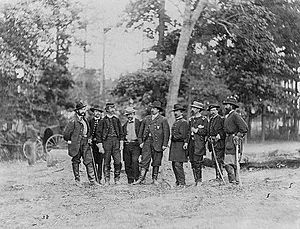William Farrar Smith facts for kids
Quick facts for kids
William Farrar Smith
|
|
|---|---|

William Farrar "Baldy" Smith
|
|
| Born | February 17, 1824 St. Albans, Vermont, US |
| Died | February 28, 1903 (aged 79) Philadelphia, Pennsylvania, US |
| Place of burial | |
| Allegiance | United States of America Union |
| Service/ |
United States Army Union Army |
| Years of service | 1845–1867 |
| Rank | |
| Commands held | VI Corps IX Corps XVIII Corps |
| Battles/wars | American Civil War |
| Signature | |
William Farrar Smith (February 17, 1824 – February 28, 1903) was a Union general during the American Civil War. He was known by his nickname, "Baldy" Smith. He was famous for both great successes and difficult challenges.
Smith was praised for his bravery in battles like the Seven Days Battles and the Battle of Antietam. However, he faced problems after the Battle of Fredericksburg. Later, as a chief engineer, he became a hero. He helped create the "Cracker Line," a supply route that saved an army from starving. This helped the Union win the Chattanooga Campaign.
Later, during the first attack on Petersburg, Smith hesitated. This delay might have cost the Union a chance to end the war sooner. Because of this, he was removed from his command.
Contents
Early Life and Education
William Farrar Smith was born in St. Albans, Vermont. His friends called him "Baldy." He was a cousin of J. Gregory Smith, who became the governor of Vermont.
In 1841, Smith began studying at the United States Military Academy in West Point. He graduated four years later, ranking fourth in his class. After graduating, he joined the Topographical Engineers Corps. He worked on mapping and surveying different areas.
Mapping and Health Challenges
Smith helped survey the Great Lakes and parts of Texas, Arizona, Florida, and Mexico. While working in Florida, he got malaria. He recovered, but the illness affected his health for the rest of his life.
In 1856, Smith started working with the lighthouse service. He eventually became the Engineer Secretary of the Lighthouse Board. He also taught mathematics at West Point twice.
Service in the Civil War
When the American Civil War began, Smith served as a staff officer. In August 1861, he became a brigadier general in the Union Army. He helped organize the 1st Vermont Brigade.
Early Battles and Promotions
Smith showed great bravery in the Seven Days Battles. He was recognized for his actions at the Battle of White Oak Swamp. In July 1862, he was promoted to major general. He led his division bravely at the Battle of Antietam.
After his commander was reassigned, Smith took charge of the VI Corps. He led them at the difficult Battle of Fredericksburg.
Challenges and Comeback
After the Battle of Fredericksburg, there were many disagreements among the generals. President Abraham Lincoln had to step in. Smith lost his command and his rank as major general. He became a brigadier general again.
During the Gettysburg Campaign, Smith led a group of militia troops in Pennsylvania. He helped stop Confederate General J.E.B. Stuart at Carlisle.
The "Cracker Line" Success
In October 1863, Smith became the chief engineer for the Army of the Cumberland. He planned and led the Battle of Brown's Ferry. This battle opened the "Cracker Line." This important supply route brought food and help to Union troops stuck in Chattanooga.
His work was highly praised. A report in 1865 said that General Smith had "saved the Army of the Cumberland from capture." Because of his success, he was again promoted to major general. General Ulysses S. Grant was very impressed with Smith's engineering skills.
Later War Service
In 1864, Grant assigned Smith to command the XVIII Corps. He led his troops in the Battle of Cold Harbor and the first attacks on Petersburg. Smith's corps was ordered to capture Petersburg. He carefully studied the enemy's defenses. He saw that the defenses were mainly guarded by artillery.
However, Smith delayed the attack. He became worried about rumors that General Robert E. Lee was arriving. This hesitation, possibly due to his recurring malaria, might have cost the Union a chance to end the war much sooner. On July 19, 1864, he was removed from command. He spent the rest of the war on "special duty."
After the War
After the Civil War, William Farrar Smith left the army in 1867. From 1864 to 1873, he was the president of the International Telegraph Company. He also served on the police board in New York City from 1875 to 1881. He became its president in 1877.
Later, he worked as a civil engineer in Pennsylvania. He passed away in Philadelphia in 1903. He is buried at Arlington National Cemetery. His own story, Autobiography of Major General William F. Smith, 1861–1864, was published after his death.
See also
 In Spanish: William Farrar Smith para niños
In Spanish: William Farrar Smith para niños


